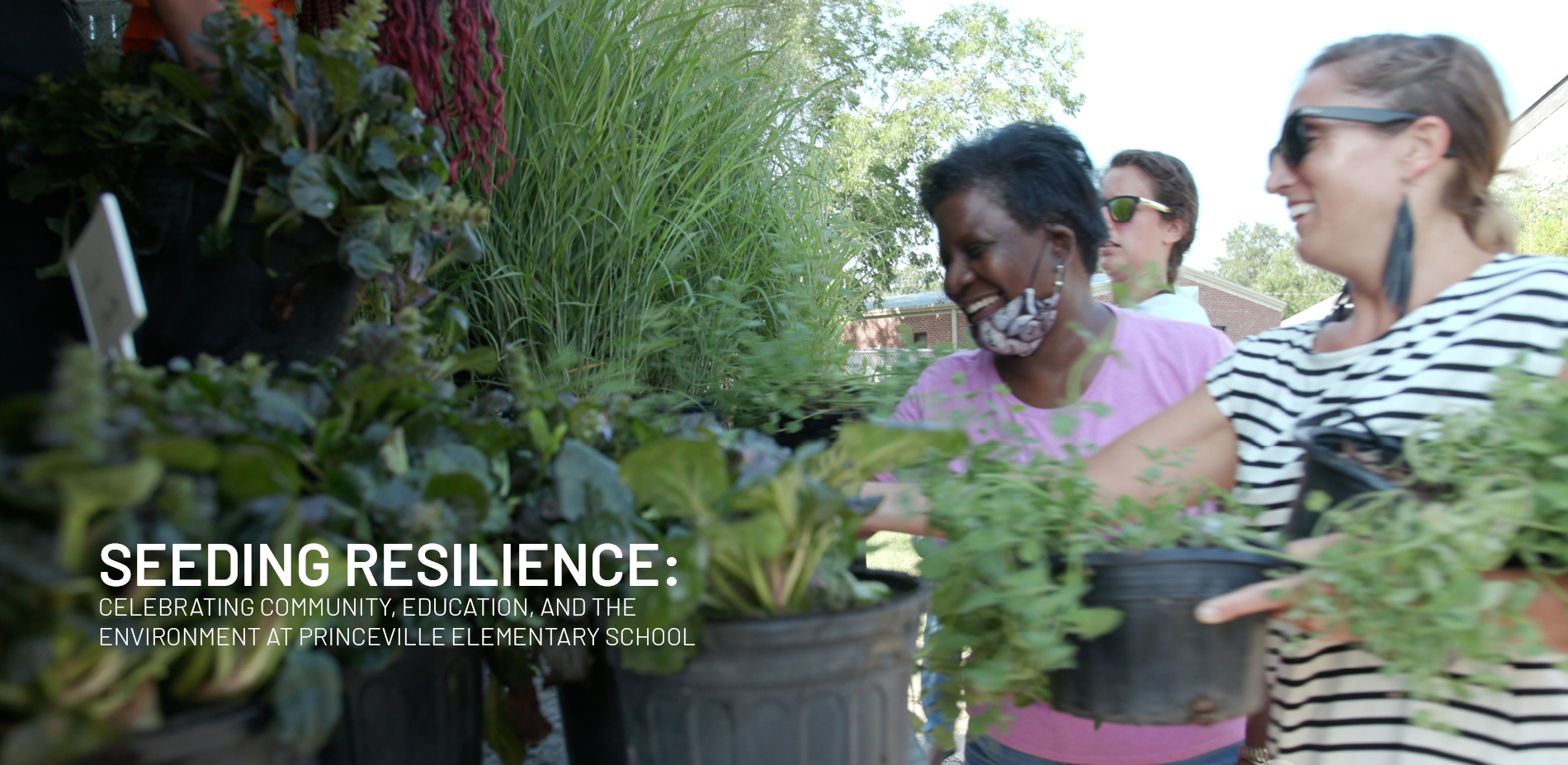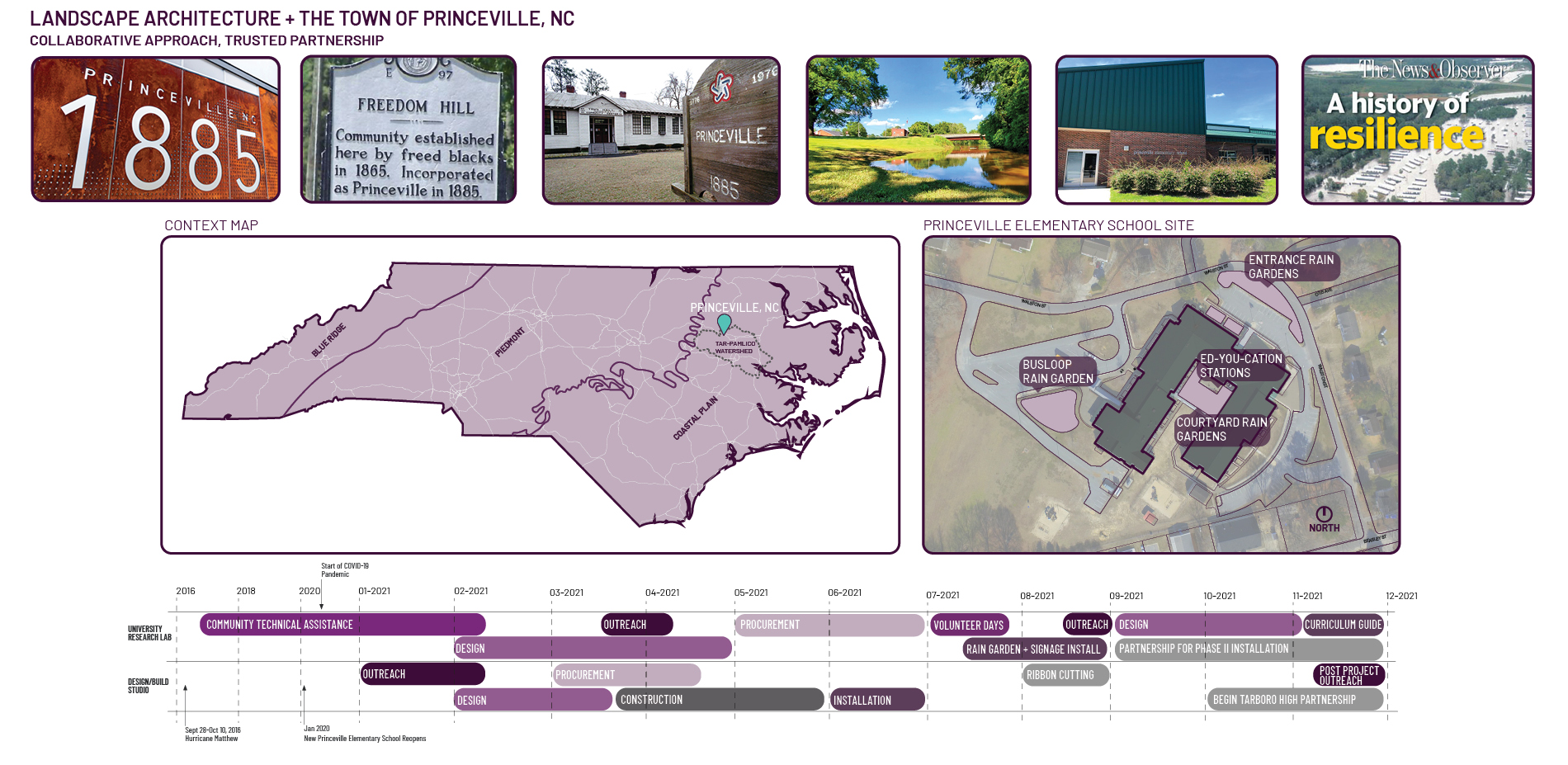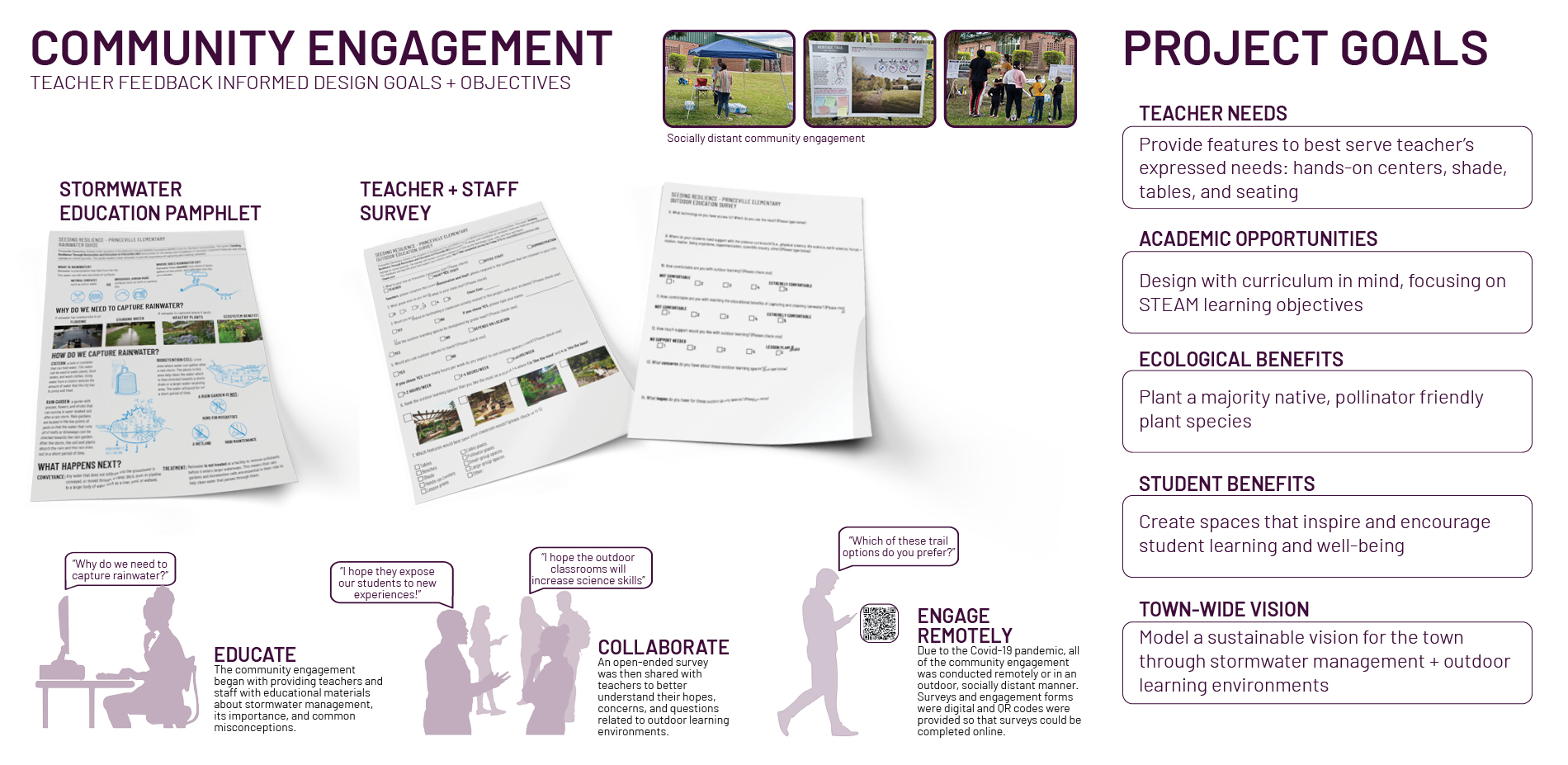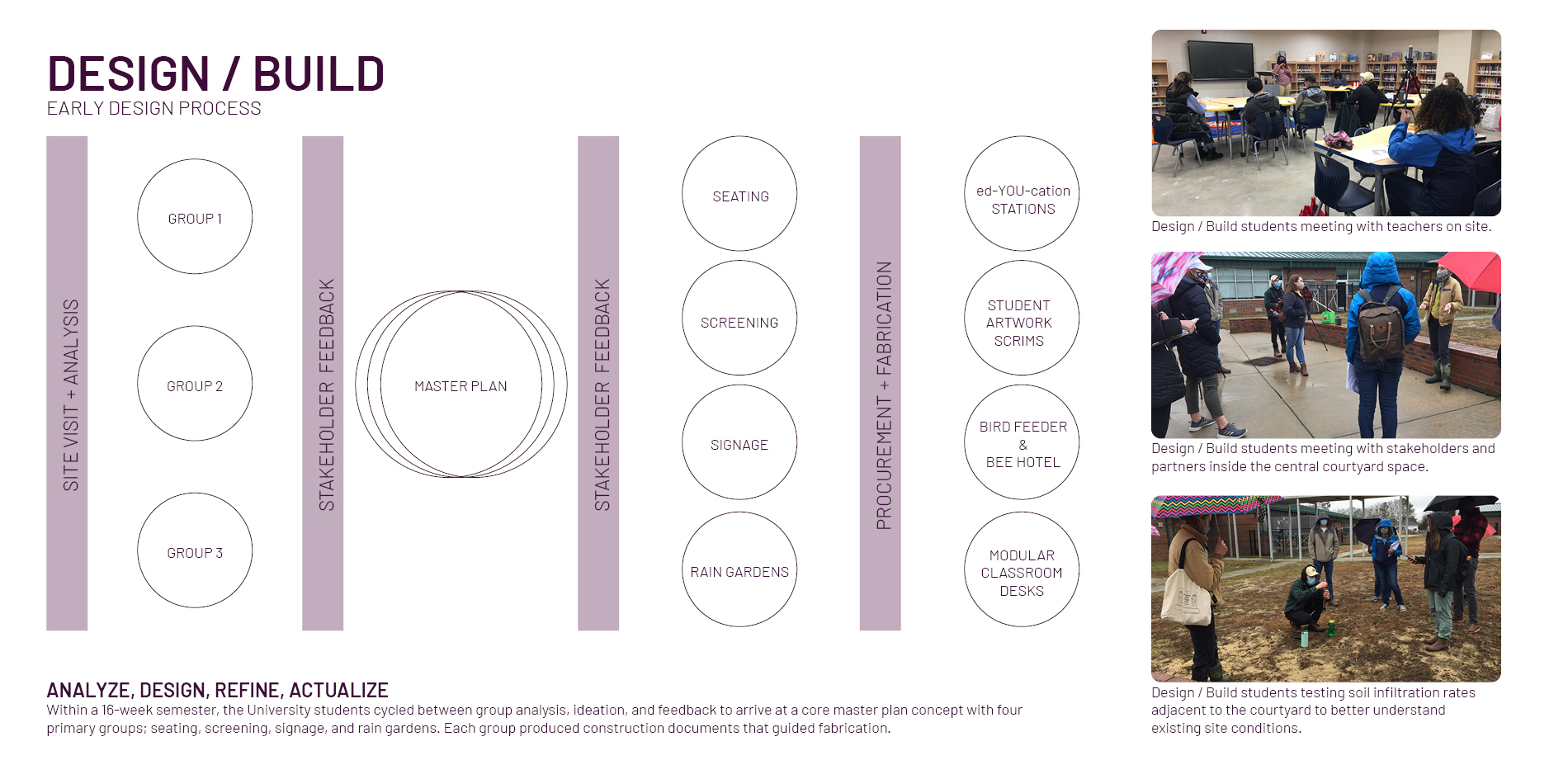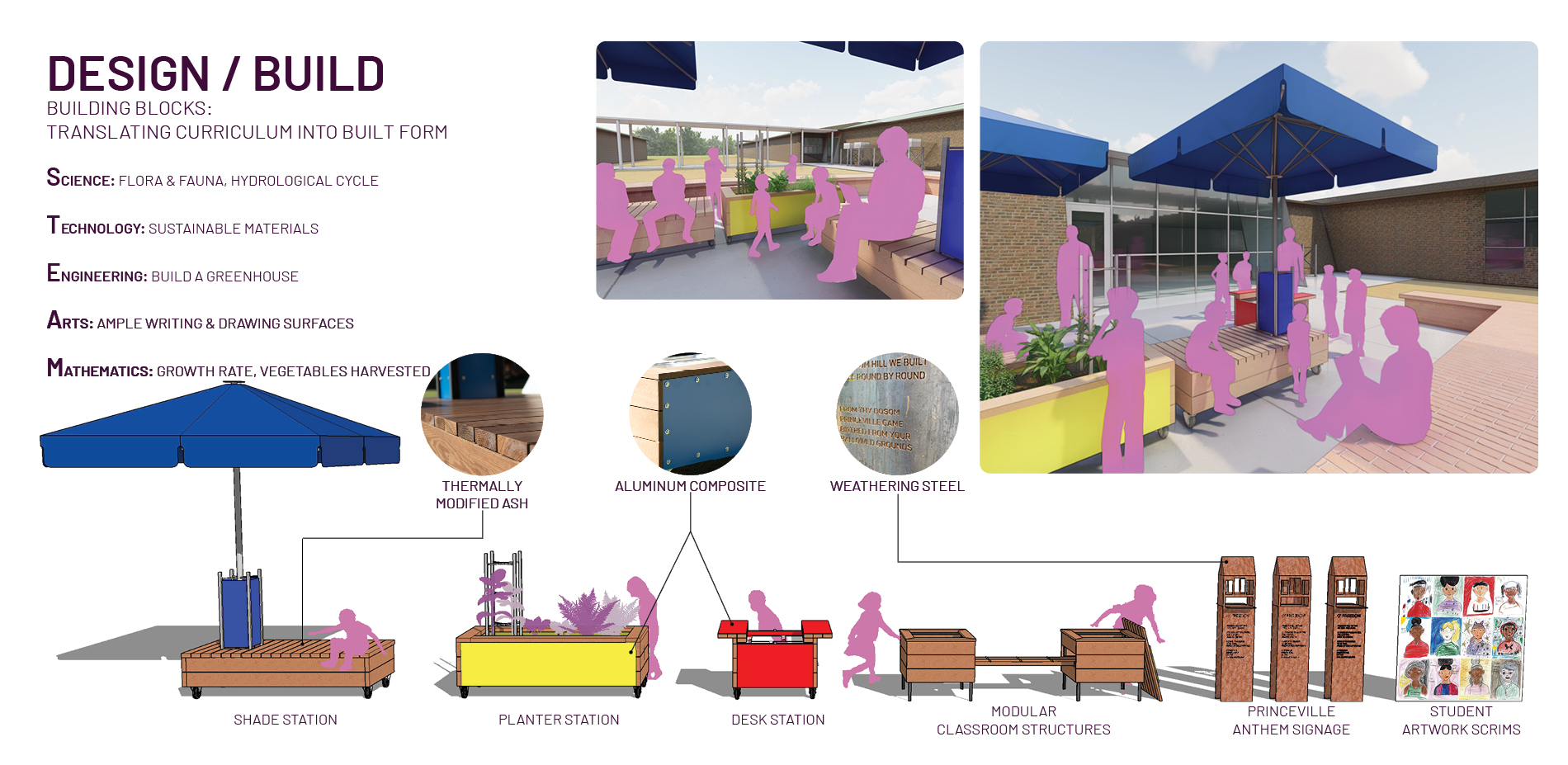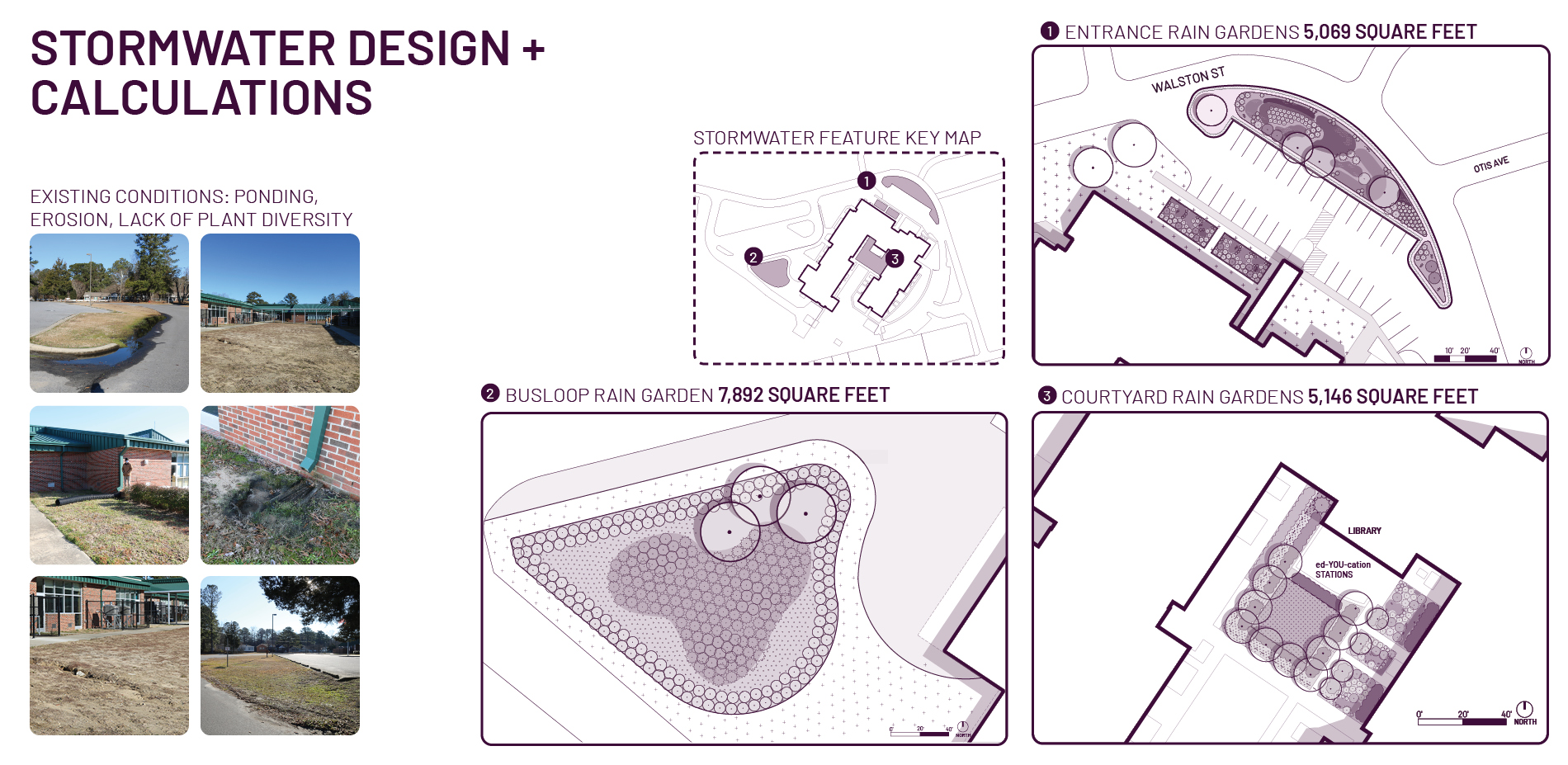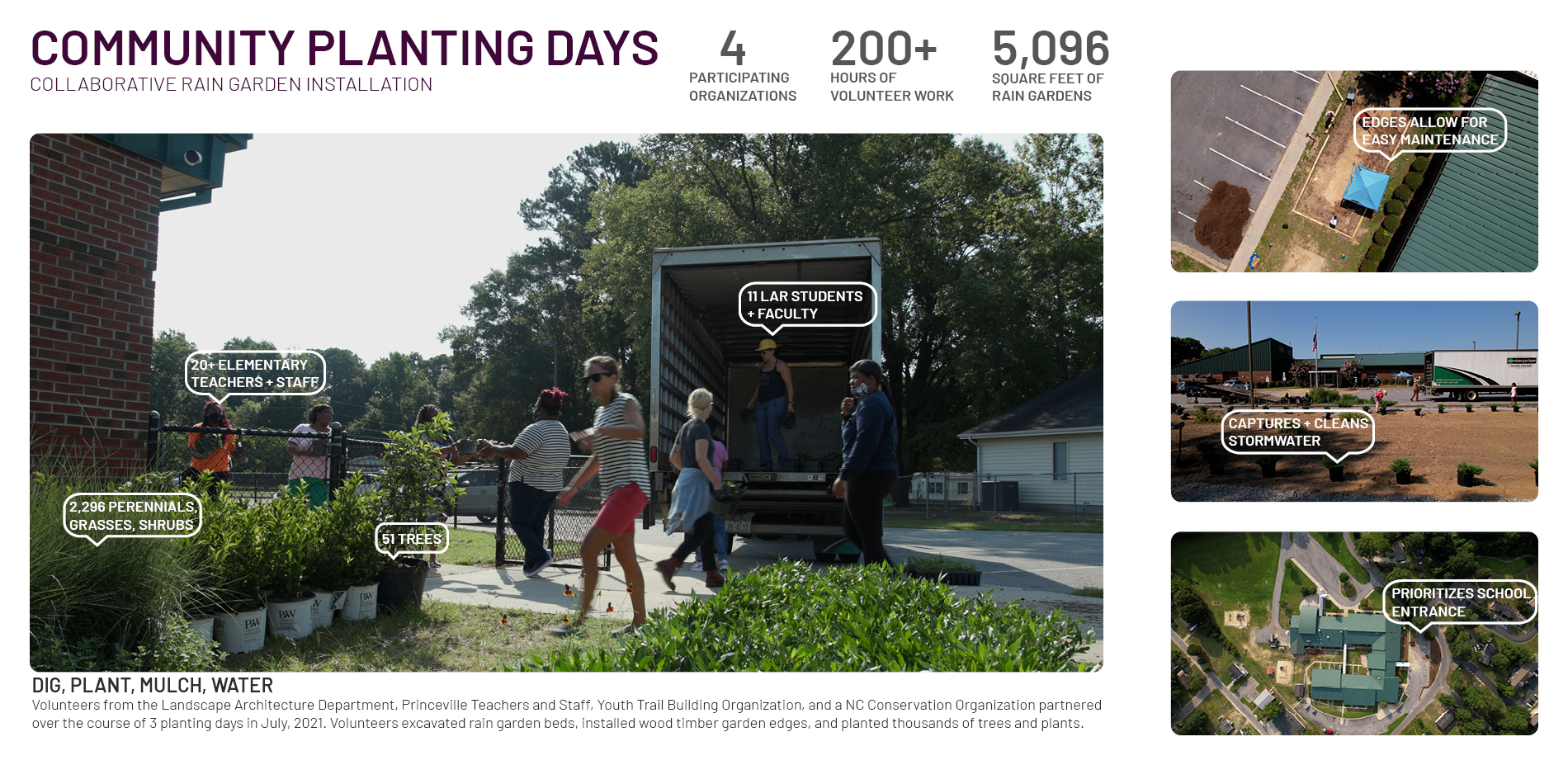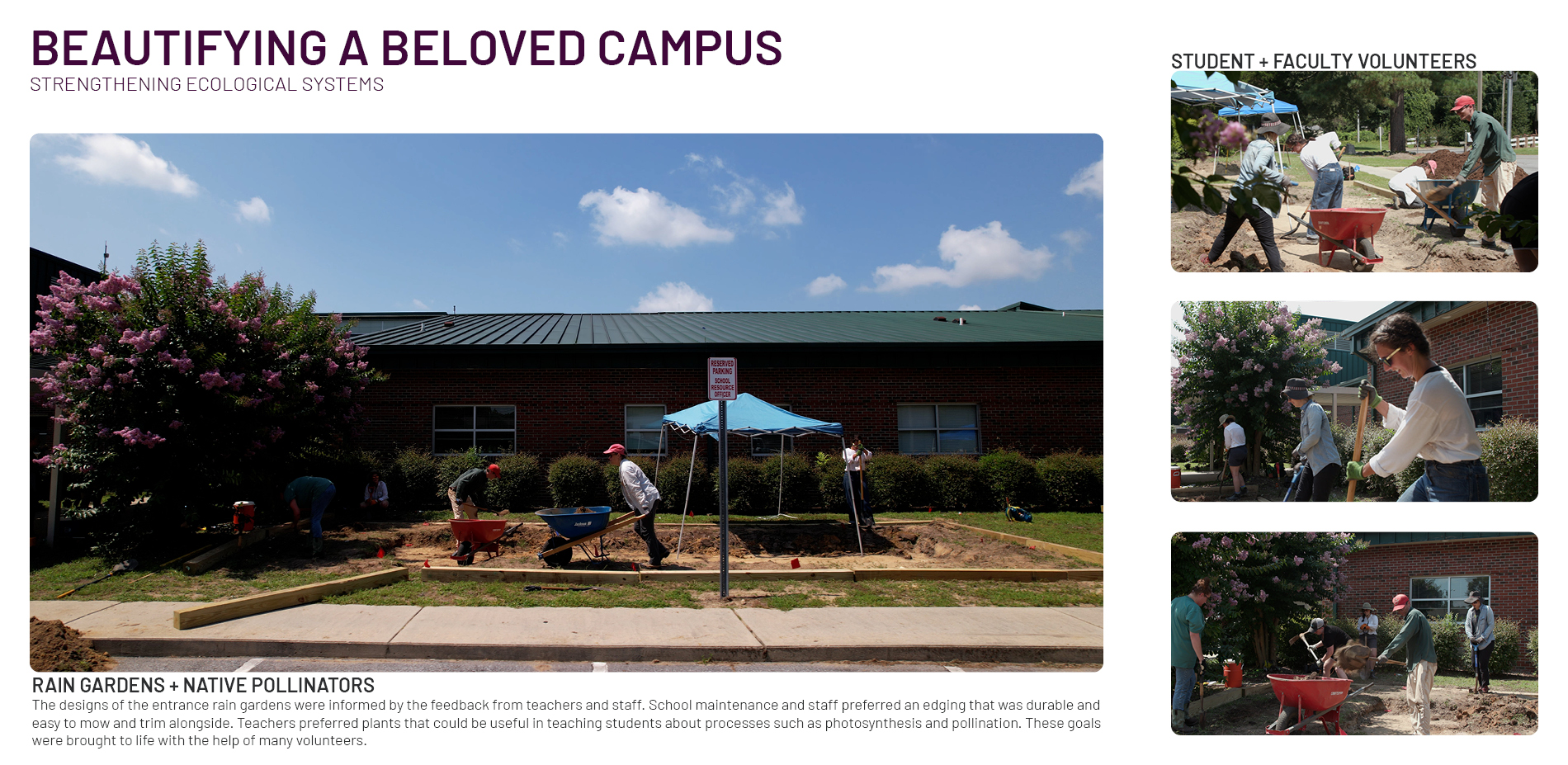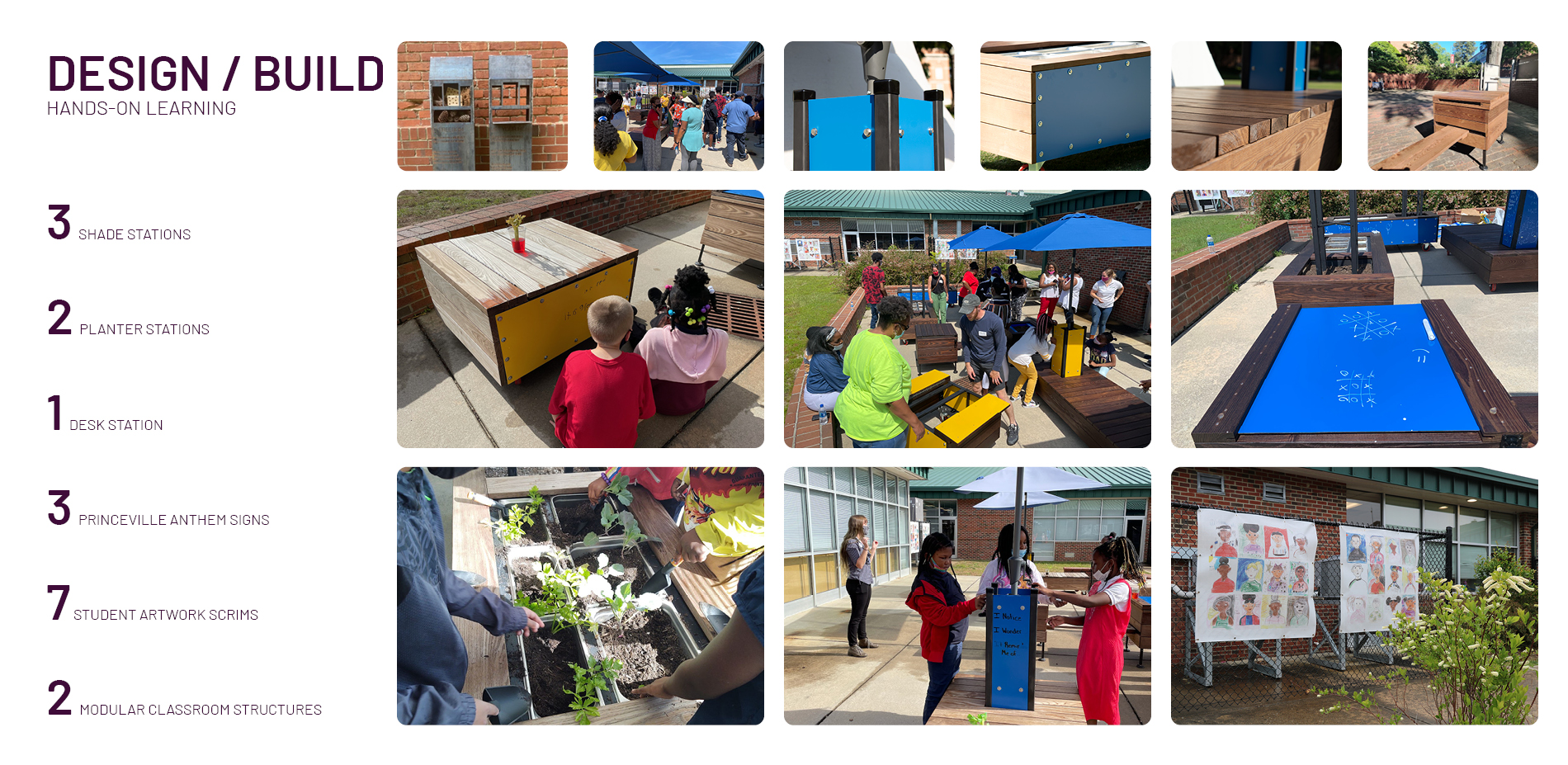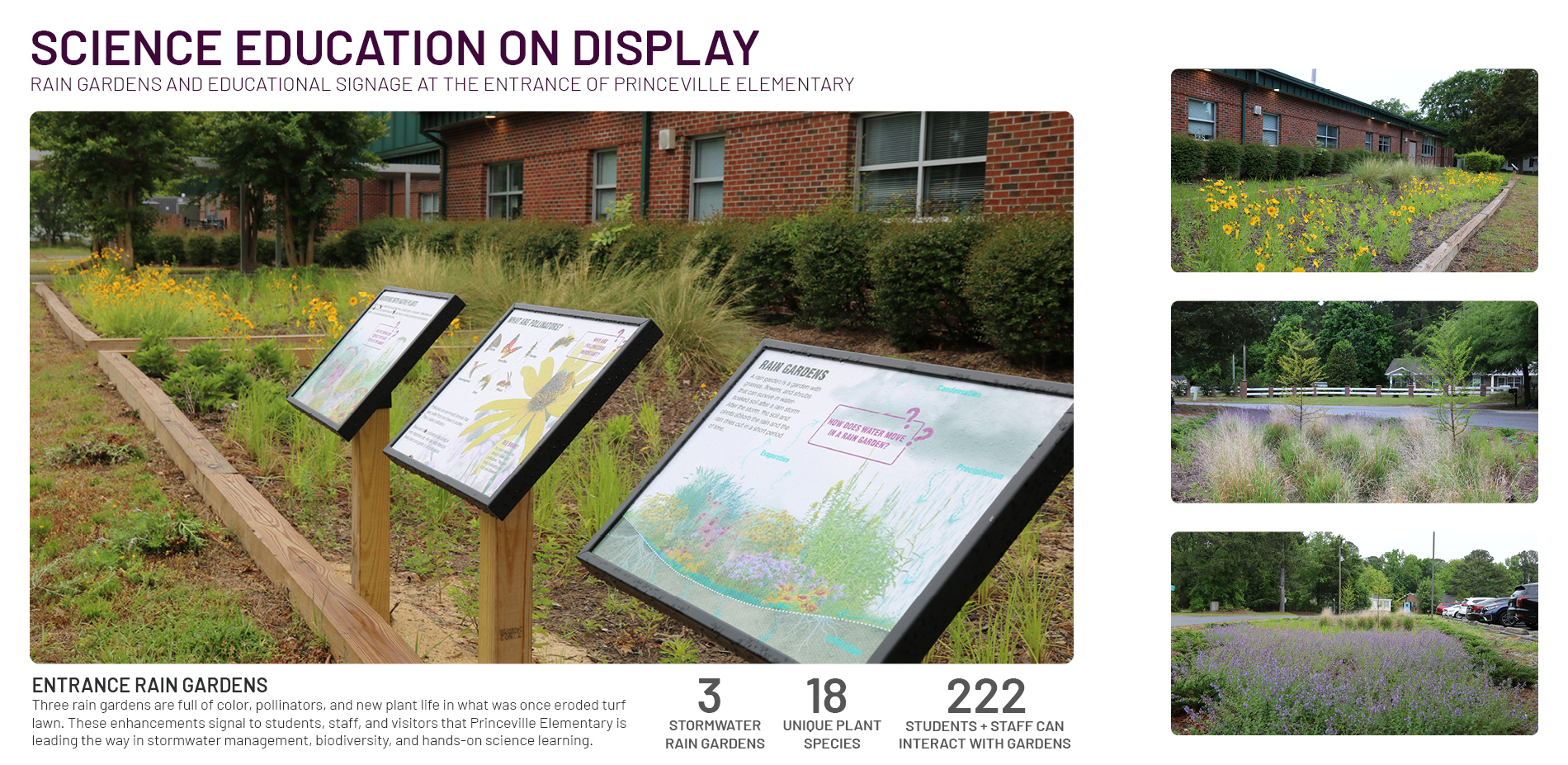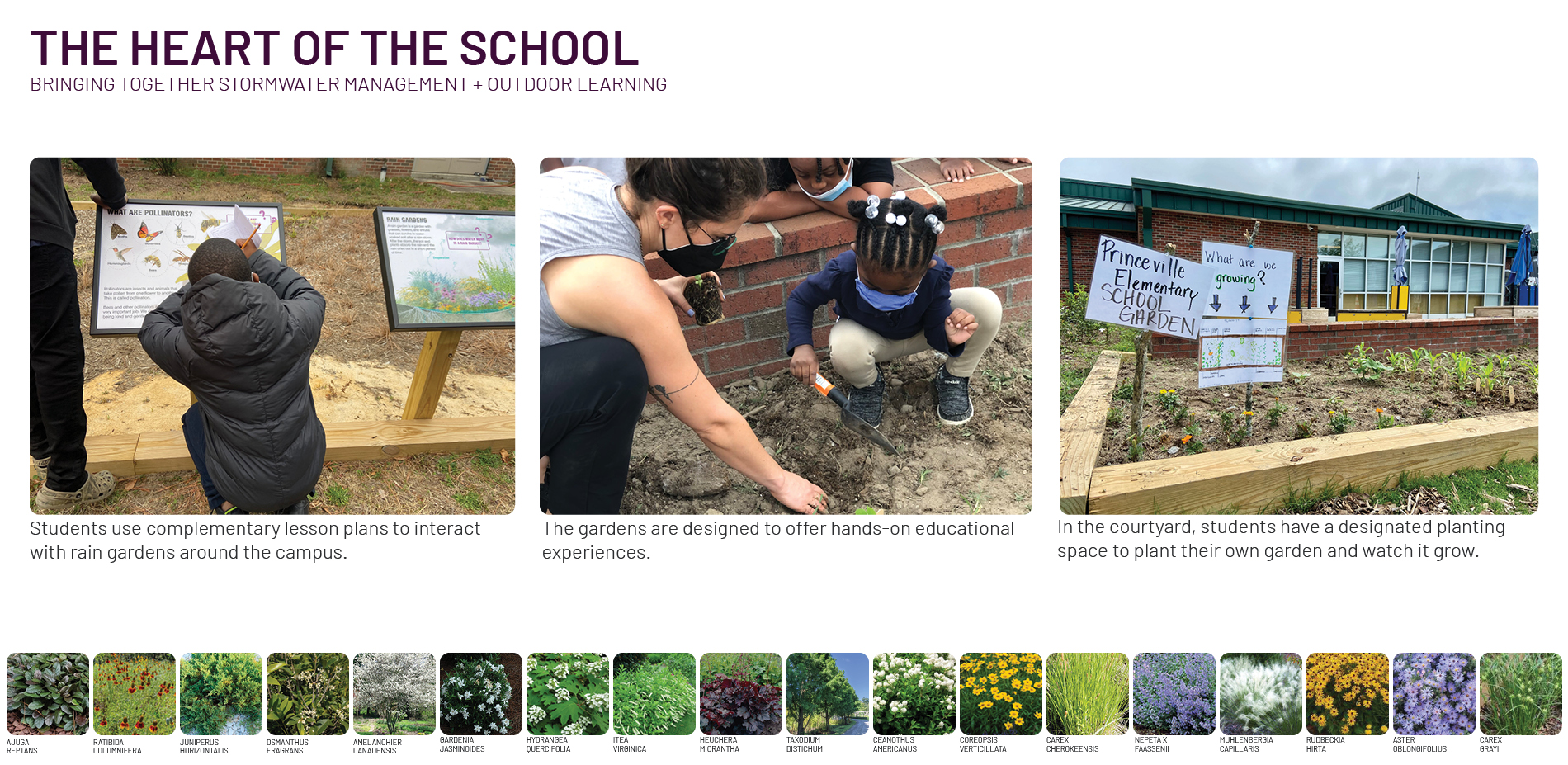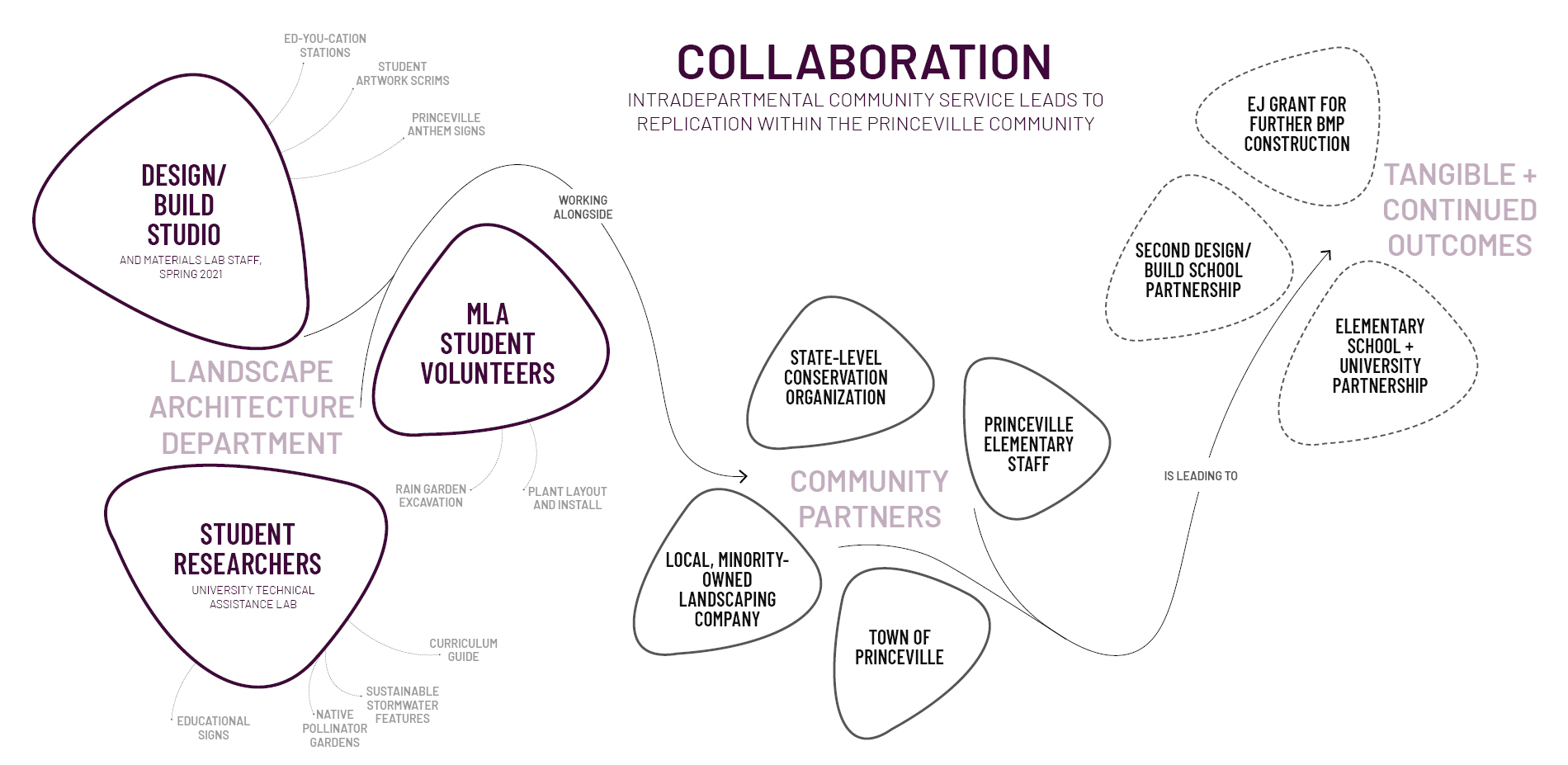Seeding Resilience: Celebrating Community, Education, and the Environment at Princeville Elementary School
Award of Excellence
Student Community Service Award
Princeville, North Carolina, United States
Spencer Stone, Associate ASLA;
Madison Sweitzer;
William Stanton;
Rebecca Asser, Associate ASLA;
Sarah Hassan;
Martha Tack, Student ASLA;
Anna Edwards;
Tianyu Shen;
Ruixin Mao;
Sara Fetty;
Faculty Advisors:
Andy Fox, FASLA;
Carla Delcambre, ASLA;
NC State University Department of Landscape Architecture and Environmental Planning
This powerful project proves the critical role landscape architecture can play in creating healthy and equitable communities in even the most challenging conditions.
- 2022 Awards Jury
Project Credits
Bobbie Jones, Linda Joyner, Dr. Glenda Knight
Town of Princeville
Tenika Mercer, Tomekia Brown, Jerome Williams
Princeville Elementary School
Chris Canfield, Mary Alice Holley
Conservation Trust of North Carolina
William Valentine FAIA, Jane Valentine, Wendy Miller FASLA PLA, James Barefoot
Project Donors
Mark Hoversten PhD FASLA AICP, Jill Orr, Chuck Flink FASLA, Meg Calkins FASLA FCELA, Nikki Evans
College of Design Staff
Travis Klondike ASLA, Madalyn Baldwin Associate ASLA
Coastal Dynamics Design Lab
Jim Dean, Christian Karkow, Rob Watson, Joe McCoy
College of Design Materials Lab
Nixzali Salcedo Pena, Ashley Stone
Teaching Assistants
Britt Davis, Angie Kealey, Alex Craig, Brittany Clark
Student Volunteers
Michael Daniels
M&M Landscaping, LLC
Project Statement
Founded in 1865 as Freedom Hill and later chartered in 1885 as the Town of Princeville (NC), “The Oldest Town Chartered by Blacks in America'' has demonstrated a legacy of resilience by recovering and rebuilding after multiple devastating floods. One example of resilience and a symbol of hope is Princeville Elementary School. After significant flooding from Hurricane Matthew (2016) damaged the school, students living in Princeville were forced to relocate to schools in nearby towns. After renovations and floodproofing, Princeville Elementary School reopened in January 2020.
Through an ongoing partnership with the town, landscape architecture students designed and implemented numerous on-site educational features, including rain gardens, multifunctional outdoor furnishings, artwork scrims featuring school artwork, educational and interpretive signage, and an integrated outdoor learning curriculum guide. These components sustainably manage stormwater, support the teachers’ and students’ curricular needs, and beautify this long-serving communal hub. Project outcomes are shaping a sustainable vision for the school, and the town more broadly, by investing in and connecting local youth to the community’s rich environmental and cultural context.
Project Narrative
Since its founding as Freedom Hill in 1865, the Town of Princeville, North Carolina (chartered in 1885) has survived the violence of Reconstruction, the institutionalized discrimination of Jim Crow, the destructive forces of urban renewal programs, and multiple devastating floods. Resilience has long characterized this community.
Princeville is currently undergoing a multi-year, post-flood recovery process as a result of Hurricane Matthew, which made landfall in the Carolinas on October 8, 2016. The Category 1 hurricane dropped 20+ inches of rain across much of eastern North Carolina, resulting in catastrophic flooding across the region. When the water finally receded two weeks later, nearly 80% of Princeville had been flooded. In addition to the destruction caused by Hurricane Matthew, Princeville has been devastated by floods eight times since its historic charter in 1885 (1887, 1919, 1924, 1923, 1940, 1958, 1999, and 2016). Despite its flood-prone past, the citizens of Princeville have always come back to rebuild and reclaim their rightful place in history as “The Oldest Town Chartered by Blacks in America.” Each flood has dramatically impacted Princeville. After Hurricane Matthew, these impacts expanded to many of the town’s core facilities, such as Town Hall, the History Museum, and the Elementary School, which were flooded and are still in the process of fully reopening.
The students and staff of Princeville Elementary School exemplify the community’s resilience. For three years following Hurricane Matthew, students living in Princeville had to attend schools in nearby towns. In January 2020, after a $6 million renovation and floodproofing, Princeville Elementary School reopened and welcomed back approximately 200 students. The school has since become a symbol of hope for revitalizing and reconnecting the community.
Collaborative Approach
Starting in 2017, a university-led technical assistance lab began its partnership with the Town of Princeville. Through many years of working with residents and town leaders to envision ways to better live with the risks of flooding while enhancing the town’s historic center, a relationship of trust and respect created an ideal foundation for the implementation of this community service project. Using an intradepartmental approach that included the lab, a design/build studio, graduate research assistants, and volunteers from the student chapter of ASLA, this project designed and installed a broad scope of stormwater interventions and outdoor learning environments. The project was delivered at no cost to the community; it was funded by an external grant and contributions from the landscape architecture program. Participating members of the landscape architecture program and their various partners believe that the myriad successes of this collaborative project have and will continue to encourage further engagements and investments in community sustainability and resilience.
Goals and Scope of Work
Graduate students collaborated from multiple branches of the department to partner with the Princeville community. Connecting students to this project through multiple departmental outlets allowed for an increased scope of work and the ability to meet Princeville Elementary’s comprehensive set of goals. Project goals centered around supporting the social, environmental, and economic resilience of the community, including increasing on-site stormwater storage, beautifying the campus, supporting teachers with outdoor learning environments and a curriculum guide, partnering with a local Black-owned business, and conducting community/teacher/staff engagement activities to inform designs.
From January 2021 to December 2021, graduate students completed the multi-phase project. The project included installing 18,000+ square feet of sustainable stormwater features, 13 educational signs, thousands of plants and 50+ trees, 7 ed-YOU-cation learning stations, student artwork scrims, and pollinator-friendly interpretive signs.
This multi-part project was the result of a comprehensive and integrated scope of work. Each element of the project consisted of research, engagement, design, engineering, fabrication, installation, maintenance guidance, and post-occupancy evaluations. Graduate researchers conducted community engagement activities and teacher surveys; created educational materials; researched stormwater designs; completed stormwater calculations; procured plant and construction materials; and created a curriculum and management guide to aid teachers in using rain gardens and tactile, outdoor learning as extensions of their classrooms. The design/build course conducted engagement with teachers and staff, researched educational design and materials, engineered and fabricated outdoor furnishings, crafted a maintenance guide for furnishings, and is conducting ongoing post-occupancy evaluations. Additionally, volunteers from the landscape architecture program played a significant role in the completion of this project. Over the course of numerous, intensive workdays and follow-up maintenance days, departmental student volunteers assisted in excavating and shaping the rain gardens and installing, mulching, weeding, and watering hundreds of plants and trees.
Research and Engagement
The success of this project stems from a long-term partnership between the town and the landscape architecture program that emphasizes co-production and follow-through. Community engagement was central to all aspects of the project. Teachers and school staff were provided with educational materials related to stormwater management and outdoor education and were surveyed remotely about their concerns and hopes for the outdoor learning environments. Additionally, students met with school stakeholders and teachers via Zoom to discuss project goals and design decisions. These engagements shaped the outcome of the design. In surveys, teachers specified features that best suited their classes, including hands-on centers, tables, seating, and curriculum support. Feedback from school maintenance staff informed the design of the rain gardens and edging materials to ensure practical and sustainable management of the new landscape features. In the same practical vein, the rain gardens were designed with installation in mind; volunteers and youth work crews assisted in the construction, therefore the design included a straightforward plan for excavation and installation.
The designs of the rain gardens were informed by research and engineering considerations. Stormwater calculations were completed to ensure the total runoff volume of a 1” rain event will be captured. Additional research was conducted into plant materials to: i) ensure suitable plants for the different microclimates and hydro-zones and ii) prioritize native and pollinator-friendly plants, both of which connect to and enrich the school's existing STEAM curriculum.
Results and Future Outcomes
The students' work resulted in a wide variety of benefits for the school and community. The educational furnishings enable classes to gather outside due to their shade umbrellas and flexible seating arrangements. They also serve as learning stations that enable students to plant and observe vegetables as they grow. The furnishings were designed to be interactive, with vibrant yellow and blue aluminum composite that allows teachers and students to write directly on the structures themselves using dry-erase markers. The student artwork scrims serve a dual purpose of screening elevated HVAC units while showcasing the students' art to further their sense of belonging and ownership of the courtyard space.
The rain gardens were designed with an emphasis on native plants and pollinators. These areas connect to the STEAM curriculum that enhances learning outcomes tied to natural processes such as photosynthesis, the water cycle, and pollination, while adding a beautiful plant palette to their beloved campus. Educational signs with guiding questions are strategically placed alongside the rain gardens and along the new Princeville Heritage Trail to both inform and engage students and community members about the ecological benefits of the environments around them.
The success of this project has further strengthened the department’s partnership with the Princeville community. The year of student involvement has benefited the school, the town, the local economy, and the natural environment. As an important component of this enduring relationship, the successes of the project have led to it being quickly embraced by the community. This success has catalyzed further recovery investments for the town, including receiving another environmental justice grant that is funding the installation of community gardens and additional sustainable stormwater features. Outcomes also extend to the broader community; the design/build studio partnership has since expanded to include a second project with Edgecombe County High School. Without a doubt, this project and the resultant projects to come will continue to support and strengthen the resilience of the elementary school and the entire Princeville community.
Plant List:
- Bugleherb (Ajuga reptans)
- Upright Prairie Coneflower (Ratibida columnifera)
- Creeping Juniper (Juniperus horizontalis)
- Sweet Osmanthus (Osmanthus fragrans)
- Serviceberry (Amelanchier canadensis)
- Gardenia (Gardenia jasminoides)
- Oakleaf Hydrangea (Hydrangea quercifolia)
- Virginia Sweetspire (Itea virginica)
- Crevice alumroot (Heuchera micrantha)
- New Jersey Tea (Ceanothus americanus)
- Whorled Tickseed (Coreopsis verticillata)
- Cherokee Sedge (Carex Cherokeensis)
- Catmint (Nepeta × faassenii)
- Muhly Grass (Muhlenbergia capillaris)
- Black-eyed Susan (Rudbeckia hirta)
- Oblong-leaved Aster (Aster oblongifolius)
- Gray's Sedge (Carex grayi)
- Bald Cypress (Taxodium distichum)
- White Oak (Quercus alba)
- Willow Oak (Quercus phellos)
- Swamp Red Oak (Quercus falcata)
